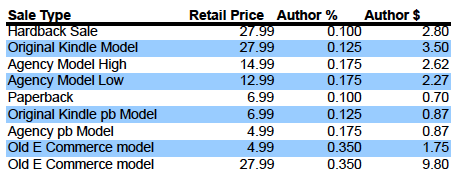This post was written by Michael A. Stackpole. It originally appeared on his Stormwolf website on 2/10/10, is reprinted here in its entirety with his permission, and is the ninth installment in his series on common myths and distractions in authorship and publishing. The first installment is here, the second is here, the third is here, the fourth is here, the fifth is here, the sixth is here, the seventh is here and the eighth is here.
An excellent post by April Hamilton [here] at Publetariat.com got me looking at the actual numbers on the money paid to authors under the old system for the Kindle, and the new Agency Model. Under the old model, ebook royalties were still connected to the cover price of a physical book. Under the agency model, they are linked to the retail price of the ebook. In both cases the author gets a cut of what the publisher receives.
Under the old model, it didn’t matter what Amazon decided to sell the book for. Amazon would pay the publisher 50% of the cover price. The author would then get his cut of that. (Prior to 2009, most contracts called for publishers to split that income 50-50. New contracts have been pushing a 25/75 split in favor of the publisher.) An author with a 25% ebook royalty rate, under the old system, would be getting 12.5% of the cover price for each sale, regardless of the discounted ebook price. Because most authors have a 10% royalty rate on physical books, every ebook copy sold by Amazon actually resulted in an increase in the amount of money the author got. Under that old model, ebook sales were better than hardback sales for an author, as the chart below indicates on the first two lines.

Under the new Agency Model, publishers will set their own prices for ebooks, with the $14.99-$12.99 price range for most hardbacks being commonly cited. Prices as low as $4.99 for older books has also been mentioned. The publisher will then get 70% of the money collected for each sale. Because authors get 25% of this 70%, their effective royalty rate is 17.5%, based on the ebook price.
As lines 3 & 4 on the chart show, under the agency model, authors who have a hardback selling for $27.99, and the ebook version selling for $14.99 will make twenty cents less on an ebook transaction over the hardback sale and nearly a dollar less than on an ebook sale under the original Amazon model. And if we were to set the price lower, to the Amazon-desired price point of $9.99, authors fare even worse.
So, the great victory over Amazon actually costs authors money.
The chart’s last five lines examine the price structure for paperback sales and the percentages for authors who signed contracts prior to 2009 and have a higher percentage of ebook receipts. While paperback-level pricing returns are slightly better for ebook sales over paper sales; you’ll notice a significant increase under the old contracts where a 50% share of the net receipts translates into a 35% royalty on retail price.
In short, before publishers decided to get greedy with a market niche that they all claim is somewhere between 1-10% of the business, writers did a lot better. Amazon and their pricing structure, which actually was being subsidized by Amazon, paid authors more, pure and simple.
Let’s be clear. Publishers are fighting for the agency model and the right to to set their own prices simply because they make more money that way. They, just like Amazon and every other corporation, acts in its own enlightened self-interest. What they think of as enlightened, however, can appear to many of us as short-sighted. As I showed previously, digital sales are actually more profitable for publishers, so they should hasten the transition and use that money to underwrite physical publication—much as Baen Books does.
It is also critical to point out that writers, while they have a dog in this fight, have no voice in it. Why do authors accept 25% of ebook receipts today when, two years ago the offer was 50%? Because we have no choice, or, rather, the choice is take it or leave it. If your boss comes to you today and says, “Either you take a 15% pay cut or I have to fire you,” what do you? If you have no alternatives, you accept the paycut
So, where’s the silver lining? How do authors win with the Agency Model?
Publish work electronically yourself. Then you’re not splitting the take with anyone aside from the retailer. (And you get the money faster.) Every author should realize something critical. If the publishers are pushing to maximize their money for digital publications by taking money from Amazon, and taking money from authors, they clearly believe this market segments is going to grow quickly. The fact is we’ve already seen demographic data that suggests that people who own ereaders buy more.
Authors can benefit directly by publishing themselves. Even if it’s not new material, but short stories and out of print books, it will sell. If you don’t do it, you leave money on the table.
And if you don’t do it, you won’t have an alternative when the publishers come to you and say, “You know what, 25% is too much for you for ebook sales. 15% or we have to let you go.” That day will come, and all writers want to be ready.
©2010 Michael A. Stackpole
Michael A. Stackpole is a New York times Bestselling author with over forty novels published including I, Jedi and Rogue Squadron. He was the first author to have work available in Apple’s Appstore. He has lectured extensively on writing careers in the Post-paper Era and is working on strategies for authors to profit during the trying time of transition.
